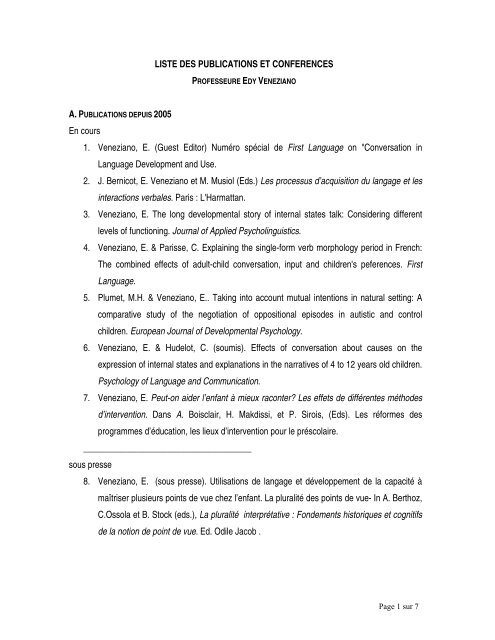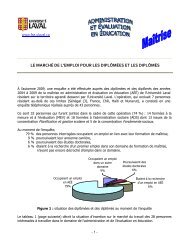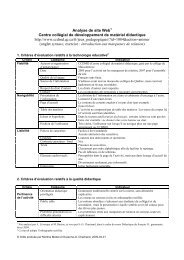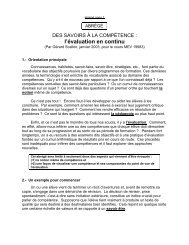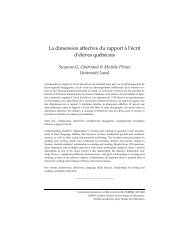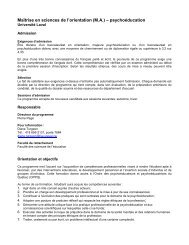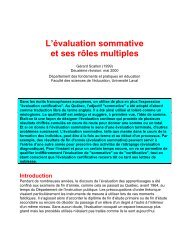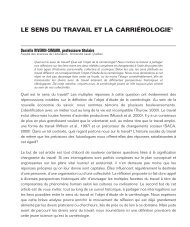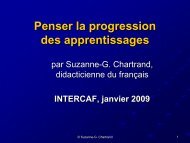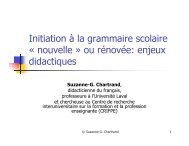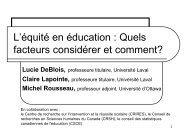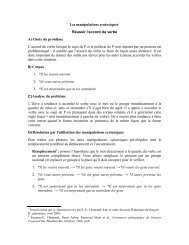Liste des publications et confénces - Professeure Edy Veneziano
Liste des publications et confénces - Professeure Edy Veneziano
Liste des publications et confénces - Professeure Edy Veneziano
Create successful ePaper yourself
Turn your PDF publications into a flip-book with our unique Google optimized e-Paper software.
LISTE DES PUBLICATIONS ET CONFERENCES<br />
PROFESSEURE EDY VENEZIANO<br />
A. PUBLICATIONS DEPUIS 2005<br />
En cours<br />
1. <strong>Veneziano</strong>, E. (Guest Editor) Numéro spécial de First Language on "Conversation in<br />
Language Development and Use.<br />
2. J. Bernicot, E. <strong>Veneziano</strong> <strong>et</strong> M. Musiol (Eds.) Les processus d’acquisition du langage <strong>et</strong> les<br />
interactions verbales. Paris : L'Harmattan.<br />
3. <strong>Veneziano</strong>, E. The long developmental story of internal states talk: Considering different<br />
levels of functioning. Journal of Applied Psycholinguistics.<br />
4. <strong>Veneziano</strong>, E. & Parisse, C. Explaining the single-form verb morphology period in French:<br />
The combined effects of adult-child conversation, input and children's peferences. First<br />
Language.<br />
5. Plum<strong>et</strong>, M.H. & <strong>Veneziano</strong>, E.. Taking into account mutual intentions in natural s<strong>et</strong>ting: A<br />
comparative study of the negotiation of oppositional episo<strong>des</strong> in autistic and control<br />
children. European Journal of Developmental Psychology.<br />
6. <strong>Veneziano</strong>, E. & Hudelot, C. (soumis). Effects of conversation about causes on the<br />
expression of internal states and explanations in the narratives of 4 to 12 years old children.<br />
Psychology of Language and Communication.<br />
7. <strong>Veneziano</strong>, E. Peut-on aider l’enfant à mieux raconter? Les eff<strong>et</strong>s de différentes métho<strong>des</strong><br />
d’intervention. Dans A. Boisclair, H. Makdissi, <strong>et</strong> P. Sirois, (Eds). Les réformes <strong>des</strong><br />
programmes d’éducation, les lieux d’intervention pour le préscolaire.<br />
______________________________________<br />
sous presse<br />
8. <strong>Veneziano</strong>, E. (sous presse). Utilisations de langage <strong>et</strong> développement de la capacité à<br />
maîtriser plusieurs points de vue chez l’enfant. La pluralité <strong>des</strong> points de vue- In A. Berthoz,<br />
C.Ossola <strong>et</strong> B. Stock (eds.), La pluralité interprétative : Fondements historiques <strong>et</strong> cognitifs<br />
de la notion de point de vue. Ed. Odile Jacob .<br />
Page 1 sur 7
9. <strong>Veneziano</strong>, E. & Plum<strong>et</strong>, M.H. (sous presse, 2009). La négociation dans les interactions<br />
conflictuelles : Une contribution à l'évaluation différentielle d'enfants autistiques de "haut<br />
niveau". Enfance.<br />
10. <strong>Veneziano</strong>, E. (sous presse, 2009). Processus inter <strong>et</strong> intra dans l'acquisition <strong>et</strong> le<br />
fonctionnement du langage. In Cahiers du Service de la Recherche en Education du<br />
Canton de Genève.<br />
__________________________________________________________________<br />
11. C. Hudelot, A. Salazar Orvig <strong>et</strong> E.<strong>Veneziano</strong> (Eds). (2008). L'explication : enjeux cognitifs <strong>et</strong><br />
communicationnel. Paris : Pe<strong>et</strong>ers. 268p.<br />
12. <strong>Veneziano</strong>, E. (2008). L'émergence <strong>des</strong> explications de type "pourquoi" dans l'interaction<br />
naturelle mère-enfant avec attention particulière aux situations conflictuelles : métho<strong>des</strong><br />
d'analyse <strong>et</strong> un modèle d'acquisition. In C. Hudelot, A. Salazar Orvig <strong>et</strong> E. <strong>Veneziano</strong> (Eds.)<br />
L'explication : enjeux cognitifs <strong>et</strong> communicationnels. Paris : Pe<strong>et</strong>ers.<br />
13. <strong>Veneziano</strong>, E., Albert, L. & Martin, S. (2008). Learning to tell a story of false belief : A<br />
study of French-speaking children. In E. Lieven, J. Guo, N. Budwig, S. Ervin-Tripp, K<br />
Nakamura & S. Özçaliskan (Eds), Crosslinguistic approaches to the psychology of<br />
language: Research in the tradition of Dan Isaac Slobin. (pp. 409-427). Mahwah, NJ:<br />
Erlbaum.<br />
14. <strong>Veneziano</strong>, E. & Hudelot, C. (2008). Processus discursifs dans le développement de la<br />
cohérence narrative. In J.M. Hoc & Y. Corson (Eds.), Actes du Congrès 2007 de la Société<br />
Française de Psychologie (pp. 121-128). [http://www.sfpsy.org/IMG/pdf/actes-<br />
SFP2007.pdf].<br />
15. <strong>Veneziano</strong>, E. (2007). Le langage dans le jeu de fiction : Une manière d'évaluer la théorie<br />
implicite de l'esprit chez le jeune enfant. Travaux Neuchâtelois de Linguistique, 46,19-32<br />
16. <strong>Veneziano</strong>, E. & Hudelot, C. (2007). Interaction <strong>et</strong> développement de la cohérence<br />
narrative. Actualités Psychologiques, 19, 41-46<br />
17. Bernicot, J., Salazar Orvig, A. & <strong>Veneziano</strong>, E. (2006). Les reprises: dialogue, formes,<br />
fonctions <strong>et</strong> ontogenèse. La Linguistique, 42 (2), 29-50.<br />
18. <strong>Veneziano</strong>, E. & Hudelot, C. (2006). Etats internes, fausse croyance <strong>et</strong> explications dans<br />
les récits: eff<strong>et</strong>s de l’étayage chez les enfants de 4 à 12 ans. Langage <strong>et</strong> l'Homme, 41 (2),<br />
117-138.<br />
Page 2 sur 7
19. <strong>Veneziano</strong>, E. & Hudelot, C. (2005). Conduites explicatives dans la narration <strong>et</strong> eff<strong>et</strong> de<br />
l’étayage: Métho<strong>des</strong> d’analyse <strong>et</strong> quelques résultats qualitatifs tirés d’une étude<br />
développementale <strong>et</strong> comparative d’enfants typiques <strong>et</strong> d’enfants dysphasiques. Travaux<br />
Neuchâtelois de Linguistique (TRANEL), 42, 81-103.<br />
20. <strong>Veneziano</strong>, E. (2005). Langage dans le jeu de faire semblant: Une manière d'évaluer la<br />
théorie implicite de l'esprit chez l'enfant? Langage <strong>et</strong> Pratiques, 35, 5-15.<br />
21. <strong>Veneziano</strong>, E (2005). Effects of conversational functioning on early language acquisition:<br />
When both caregivers and children matter. In B. Bokus (Ed.), Studies in the psychology of<br />
child language. Essays in honor of Grace Wales Shugar. (pp. 47-69). Warsaw: Matrix.<br />
22. <strong>Veneziano</strong>, E. (2005). Vers l'attention conjointe dans "l'ailleurs" <strong>et</strong> la prise en compte du<br />
mental d'autrui : une convergence de développements cognitifs, sociaux <strong>et</strong> langagiers. In<br />
Cahiers du Service de la Recherche en Education du Canton de Genève, Cahier 11, pp.<br />
303-318. Genève, Suisse. Scolariser la p<strong>et</strong>ite enfance ? Actes du 2e colloque<br />
"Constructivisme <strong>et</strong> Education", Vol I.<br />
23. <strong>Veneziano</strong>, E. (2005). Conduites explicatives en famille avant trois ans. In Scolariser la<br />
p<strong>et</strong>ite enfance? Actes du 2e colloque "Constructivisme <strong>et</strong> Education", Vol I. Cahiers du<br />
Service de la Recherche en Education du Canton de Genève, Cahier 11, pp. 321-331.<br />
Genève, Suisse.<br />
24. Hudelot, C. & <strong>Veneziano</strong>, E. (2005). Compétences langagières chez le jeune enfant :<br />
acquisitions <strong>et</strong> fonctionnements en interaction sociale. Introduction au symposium. In<br />
Scolariser la p<strong>et</strong>ite enfance? Actes du 2e colloque "Constructivisme <strong>et</strong> Education", Vol I.<br />
Cahiers du Service de la Recherche en Education du Canton de Genève, Cahier 11, pp.<br />
319-320. Genève, Suisse.<br />
B. AVANT 2005 : PUBLICATIONS CHOISIES<br />
25. <strong>Veneziano</strong>, E., Plum<strong>et</strong>, M.H., Cupello, S. & C. Tardif (2004). Pragmatic functioning in<br />
natural s<strong>et</strong>ting and the emergence of ‘theory-of-mind’ in autistic and control children: A<br />
comparative study. Psychology of Language and Communication, 8 (1), 25-42.<br />
26. <strong>Veneziano</strong>, E. (2004). The emergence of expressive options in early child language : a<br />
constructivist account. In D. Ravid & H. Bat-Zeev Shyldkrot (Eds), Perspectives on<br />
Page 3 sur 7
language and language development: Essays in honor of Ruth A. Berman (pp. 203-218).<br />
Dordrecht : Springer. (ISBN: 1-4020-7903-6).<br />
27. <strong>Veneziano</strong>, E. (2003). L'émergence <strong>des</strong> catégories nom <strong>et</strong> verbe <strong>et</strong> le développement de la<br />
morphosyntaxe : <strong>des</strong> relations inhérentes. In C. Brion & E. Castagne (eds) Nom <strong>et</strong> Verbe :<br />
catégorisation <strong>et</strong> référence. (pp. 271-289). Reims, France : Presses Universitaires de<br />
Reims.<br />
28. <strong>Veneziano</strong>, E. (2003). Learning to explain: A specifically pragmatic acquisition. In J.<br />
Drevillon, J. Vivier & A. Salinas (Eds). Psycholinguistics, a multidisciplinary science of<br />
2000: What implications, what applications? Paris, France : Europia.<br />
29. <strong>Veneziano</strong>, E. (2003). The emergence of noun and verb categories in the acquisition of<br />
French. Psychology of Language and Communication, 7 (1), 23-36.<br />
30. <strong>Veneziano</strong>, E. (2002). Relations entre jeu de fiction <strong>et</strong> langage avant trois ans: de<br />
l'émergence de la fonction sémiotique à celle de la "théorie de l'esprit" en action. Enfance,<br />
54, 241-257.<br />
31. <strong>Veneziano</strong>, E. (2002). Language in pr<strong>et</strong>ense during the second year: What it can tell us<br />
about “pr<strong>et</strong>ending” in pr<strong>et</strong>ense and the “know-how” about the mind. In R. Mitchell (Ed.)<br />
Pr<strong>et</strong>ense in animals and children (pp.58-72). Cambridge, UK : CUP.<br />
32. <strong>Veneziano</strong>, E. & Hudelot, C. (2002). Développement <strong>des</strong> compétences pragmatiques <strong>et</strong><br />
théories de l'esprit chez l'enfant : le cas de l'explication. In J. Bernicot, A. Trognon, M.<br />
Guid<strong>et</strong>ti & M. Musiol (eds), Pragmatique <strong>et</strong> psychologie (pp. 215-236). Nancy : Presses<br />
Universitaires de Nancy.<br />
33. <strong>Veneziano</strong>, E. (2001). Interactional processes in the origins of the explaining capacity. In K.<br />
Nelson, A. Aksu-Koc and C. Johnson (Eds.), Children’s Language, Vol. 10: Developing<br />
Narrative and Discourse comp<strong>et</strong>ence (pp. 113-141). Mahwah, N.J.: L. Erlbaum.<br />
34. <strong>Veneziano</strong>, E. (2001). A System-Approach to the Analysis of “Fillers” at the Transition to<br />
Grammar. In Almgrem, M., Barreqa, A., Ezeizabarrena, M.-J., Idiazabal, I. & MacWhinney,<br />
B. (Eds), Research on child language acquisition. (pp. 739-760.). Cascadilla Press,<br />
Sommerville, MA.<br />
35. <strong>Veneziano</strong>, E. (2001). Displacement and informativeness in child-directed talk. First<br />
Language, 21, 323-356.<br />
Page 4 sur 7
36. <strong>Veneziano</strong>, E. (2001). The importance of studying filler-producing children. Journal of Child<br />
Language, 28, 275-278.<br />
37. <strong>Veneziano</strong>, E. (2001). L'utilisation “informative“ du langage chez le jeune enfant avec<br />
référence particulière à la conduite explicative. Langage <strong>et</strong> pratiques, 27, 34-42.<br />
38. <strong>Veneziano</strong>, E & Sinclair, H. (2000). The changing status of “filler syllables” on the way to<br />
grammatical morphemes. Journal of Child Language, 27, 1-40.<br />
39. <strong>Veneziano</strong>, E. (2000). Interaction, conversation <strong>et</strong> acquisition du langage dans les trois<br />
premières années. In M. Kail & M. Fayol (eds.), L’acquisition du langage, Vol. 1,<br />
L’émergence du langage. Collection Psychologie <strong>et</strong> Sciences de la pensée. Paris : P.U.F.<br />
pp. 231-265.<br />
40. <strong>Veneziano</strong>, E. (1999). Early lexical, morphological and syntactic development in French :<br />
Some complex relations. Journal of Bilingualism, 3 (2), 183-217.<br />
41. <strong>Veneziano</strong>, E. (1999). L’acquisition de connaissances pragmatiques : apprendre à<br />
expliquer. Revue Parole, 9/10, 1-28.<br />
42. <strong>Veneziano</strong>, E. (1999). Conversational properties and early language acquisition. Verbum,<br />
XXI (2), 191-205.<br />
43. <strong>Veneziano</strong>, E. (ed) (1998). “La conversation : instrument, obj<strong>et</strong> <strong>et</strong> source de connaissance :<br />
fonctionnements <strong>et</strong> acquisitions”. Numéro spécial double de la revue Psychologie de<br />
l’Interaction, 7-8.<br />
44. Musatti, T., <strong>Veneziano</strong>, E. & Mayer, S. (1998). Contributions of language to early pr<strong>et</strong>end<br />
play. Cahiers de Psychologie Cognitive/Current Psychology of Cognition, 17 (2), 155-181<br />
45. <strong>Veneziano</strong>, E (1998). L’émergence de la morphologie grammaticale chez l’enfant : une<br />
continuité discontinue. Verbum, XX (1), 87-109.<br />
46. <strong>Veneziano</strong>, E. (1998). Les buts illocutoires de l’assertion : une nouvelle formalisation.<br />
Interaction <strong>et</strong> Cognitions Vol. II (1-2) (Psychologie de l’Interaction, 5-6), 137-148.<br />
47. <strong>Veneziano</strong>, E. (1998). La conversation : instrument, obj<strong>et</strong> <strong>et</strong> source de connaissance.<br />
Psychologie de l’Interaction, 7-8, 1-24.<br />
48. <strong>Veneziano</strong>, E. & Sinclair, H. (1997). From the surface inward: a discontinuous continuity in<br />
the emergence of grammatical morphology. Archives de Psychologie, 65, 107-116.<br />
49. <strong>Veneziano</strong>, E. (1997). Processus conversationnels <strong>et</strong> constructivisme dans les débuts du<br />
langage. Cahiers d'Acquisition <strong>et</strong> de Pathologie du Langage, 15, numéro spécial, 93-108.<br />
Page 5 sur 7
50. <strong>Veneziano</strong>, E. (1997). Echanges conversationnels <strong>et</strong> acquisition première du langage. In J.<br />
Bernicot, A. Trognon & J. Caron-Pargue (eds), Conversation, interaction <strong>et</strong> fonctionnement<br />
cognitif. (pp. 91-123). Nancy : P.U.N.<br />
51. <strong>Veneziano</strong>, E. (1996). De la co-référence contextualisée à la co-référence déplacée: les<br />
bienfaits du manque de correspondance dans la situation immédiate. Numéro spécial<br />
“Savoirs <strong>et</strong> compétences en construction”. Interaction <strong>et</strong> Cognitions, 1 (2-3), 457-479.<br />
52. <strong>Veneziano</strong>, E. & Sinclair, H. (1995). Functional changes in early child language: the<br />
appearance of references to the past and of explanations.Journal of Child Language, 22,<br />
557-581.<br />
53. <strong>Veneziano</strong>, E. (1992). G<strong>et</strong>ting expert in the old: A constructivist approach to early language<br />
acquisition. Substratum, 1, 79-101.<br />
54. <strong>Veneziano</strong>, E., Sinclair, H. & Berthoud, I. (1990). From one word to two words: rep<strong>et</strong>ition<br />
patterns on the way to structured speech. Journal of Child Language, 17, 633-650.<br />
55. <strong>Veneziano</strong>, E. (1990). Les premières manifestations <strong>des</strong> conduites d’explication. In<br />
Berthoud, I., Favre, C. & <strong>Veneziano</strong>, E., Construction <strong>et</strong> reconstruction <strong>des</strong> conduites<br />
d’explication. Cahiers d’Acquisition <strong>et</strong> de Pathologie du Langage, 7/8, 11-20.<br />
56. Berthoud, I. & <strong>Veneziano</strong>, E. (1989). La signification énonciative dans les débuts du<br />
langage. Archives de Psychologie, 57, 271-281.<br />
57. <strong>Veneziano</strong>, E. (1989). Les proto-conversations <strong>et</strong> les débuts du langage : De l'alternance<br />
<strong>des</strong> tours de rôle aux significations partagées. Revue Internationale de Psychologie<br />
Sociale, 2(1), 23-36.<br />
58. Berthoud-Papandropoulou, I., Kilcher, H. & <strong>Veneziano</strong>, E. (1989). What can children do<br />
with utterances? Linguistic and m<strong>et</strong>alinguistic activities: Theory, m<strong>et</strong>hods and results. In J.<br />
Montangero & A. Tryphon (Eds.), Cahiers de la Fondation Archives Jean Piag<strong>et</strong>, No. 10,<br />
17-28.<br />
59. <strong>Veneziano</strong>, E. (1988). Vocal-verbal interaction and the construction of early lexical<br />
knowledge. In M. D. Smith & J. L. Locke (Eds.) The emergent lexicon : The child's<br />
development of a linguistic vocabulary. (pp.109-147). New York: Academic Press.<br />
60. <strong>Veneziano</strong>, E. (1987). Les débuts de la communication langagière. In J. Gérard (Ed.)<br />
Savoir parler, savoir dire, savoir communiquer. (pp. 59-94). Neuchâtel: Delachaux &<br />
Niestlé.<br />
Page 6 sur 7
61. <strong>Veneziano</strong>, E. (1987). L'adaptation verbale : mères <strong>et</strong> enfants. In J. Gérard (Ed.) Savoir<br />
parler, savoir dire, savoir communiquer. (pp. 95-119). Neuchâtel: Delachaux & Niestlé.<br />
62. <strong>Veneziano</strong>, E. (1985). Replying to mothers' questions: A way to lexical acquisition. Journal<br />
of Pragmatics, 9, 433-452.<br />
63. Sinclair, H., Berthoud-Papandropoulou, I., Gérard, J. & <strong>Veneziano</strong>, E. (1985).<br />
Constructivisme <strong>et</strong> psycholinguistique génétique. Archives de Psychologie, 53, 37-60.<br />
64. <strong>Veneziano</strong>, E. (1981). Early language and nonverbal development: A reassessment.<br />
Journal of Child Language, 8, 541-563.<br />
Page 7 sur 7


